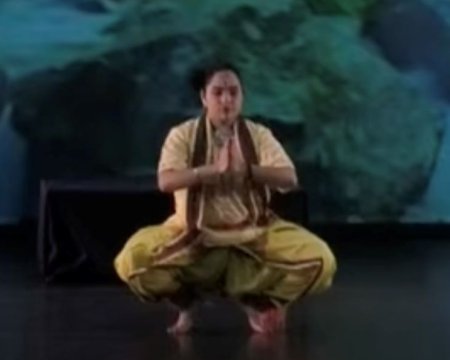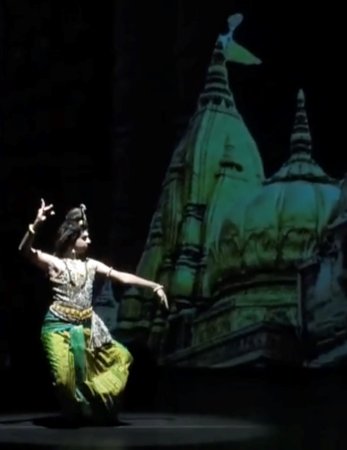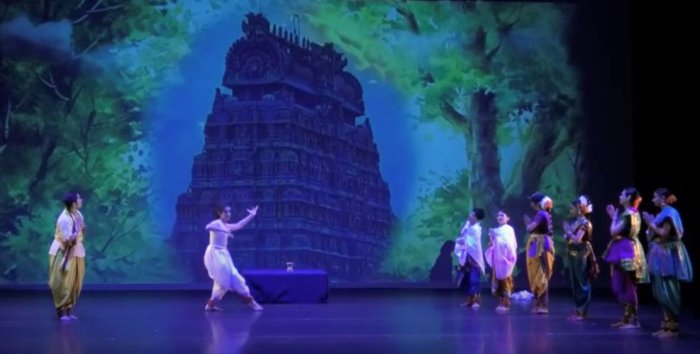
|   |

|   |
Nandanar Charitam in Kuchipudi - Priti Gosar-Patil e-mail: kalasattva@gmail.com June 24, 2024 As I stood in the spontaneous standing ovation from the audience at the end of the 'Nandanar Charitam' Kuchipudi dance drama, in my mind the following shlokas from Natyashastra's 'Dasharupakani' chapter echoed. prakhyātavastuviṣayaṁ prakhyātōdāttanāyakaṁ caiva . rājarṣivaṁśyacaritaṁ tathaiva divyāśrayōpētam .. 10.. nānāvibhūtibhiryutamr̥ddhivilāsādibhirguṇaiścaiva . aṅkapravēśakāḍhyaṁ bhavati hi tannāṭakaṁ nāma .. 11.. nr̥patīnāṁ yaccaritaṁ nānārasabhāvacēṣṭitaṁ bahudhā . sukhaduḥkhōtpattikr̥taṁ bhavati hi tannāṭakaṁ nāma .. 12.. Well known subject of a known, noble hearted hero, about divine upliftment, containing multiple acts/entries, often enriched by many rasas, generating sorrows and joy - that is 'Natakam'. I honestly can say I saw a wonderful Nritya Natakam! Sri Sai Dance Academy from Richmond, VA, led by Sarada Jammi and her daughter Ameya King presented 'Nandanar Charitam', a Kuchipudi nritya natakam as a collaboration with Deepa Narayanan Sashindran of Kuchipudi Parampara Foundation (Bangalore), at the Perkinson Center for the Arts & Education (Chester, VA) on June 16, 2024. It was conceived and choreographed by Deepa, and directed by J. Sarada with Ameya.  Nandan Nandanar also known as Tirunalaipovaar (means - The one who will go tomorrow) and Tirunalaipovaar Nayanar, born in the 12th century, was 18th of the 63 Nayanar (Great Shiva devotees) saints, who were venerated in Shaivism. He was born in an agricultural community considered untouchable. He lived with unwavering devotion to Lord Shiva, inspiring those around him to follow this path of faith. His immense devotion triumphed social barriers and caused divine miracles that led him first to the Sivalokanathar Temple in Thirupungur, then to the Thillai Natarajar Temple in Chidambaram, and finally leading to the lotus feet of his Lord Shiva. The dance drama depicted two miracles attributed to him. In Sivalokanathar temple, Thirupungur, a giant stone bull moved so they could get 'darshanam'. To date, it still appears as such in that temple. Nandanar is said to have ritually purified himself by fire at Thillai Nataraja temple, Chidambaram. Nandanar's tale features in temple lore and religious literature related to both these temples. The production began with mangalacharanam of 'Angikam Bhuvanam Yasya' from Abhinaya Darpanam, followed by a tribute song describing it to be navarasabharitam and gyaanadayakam - containing 9 rasas and giving knowledge. In the next scene, Nandanar portrayed ardent Shiva bhakti in 'Shivanamame.' Simple yet alluring melody took us into a trance and the mood was set with Nandanar played by Ameya King herself. A typical Telugu folk dance in praise of the village goddess Yellamma concluded with sacrifice of goats which was questioned by Nandanar. In conversation with his friend and fellow villagers, he explains that all living things have the same divinity within them, that Lord Shiva will protect them, that he is God to all people, and that however devotees reach out to Lord Shiva, he responds to them in that way. The villagers decide to go with Nandan to see Lord Shiva at the Sivalokanathar Temple. The concept of Navavidha Bhakti was described well through the song 'Vitalakakshudu okkare' and the journey to Thirupungur where the miracle of Nandi moving aside from the front of Shiva lingam was majestically portrayed through expressions and back-drop videos which evoked tears in the eyes of devotees in the audience. Adi Shankaracharya's Uma Maheshwara Stotram was very suitable to the whole miracle that unfolded. The 7th scene was the construction of a water reservoir at the behest of Lord Ganesha in disguise. It is called Rishabha Theertham or Kulam Vettiya Vinayagar, a Ganesh stuti by Sahaasra Sista, who in the end installs as the Ganesh was a great ending to the first part of the dance drama.  Jyotirlingas The second act of the story began with questioning the essence of Lord Shiva as Nandanar was acquainted with Thirupungur Sivalokanathar temple. Shiva explains his presence in 12 jyotirlingas depicted by Sahaj Sagiraju as Shiva and Pavithra Polepalli as Sutradhara or Nandanar's antaraatmaa questioning through the song 'Evaridi ee Pilupu' which convinces Nandanar to immediately start his journey towards Chidambaram. He seeks permission from his landlord but is unable to explain what Chidambaram stands for through the song 'Mayajagamuna.' Upon Lord Shiva's suggestion, Goddess Shivagami explains the essence of Chidambaram which was depicted by Vindhya Nagandla in a shabdam format with eloquent and meaningful song 'Chidambara manina' composed in simple yet evoking melody. With conviction, Nandan again reaches out for permission with his landlord. The landlord agrees, but on condition that Nandan ploughs and tills acres of land into full harvest by sunrise. Upon hearing this impossible condition, miserable Nandan cries with a heavy heart that reaches Shivagami. Merciful mother convinces Lord Shiva to intervene and brings her family together, descends to earth and brings about the miracle with the song 'Shiva parivaramu.' It has wonderful choreography and accompanying sand arts background images evoke deep bhakti in the devout. This miracle astonished the landlord. His ego melts and he asks Nandan to explain the path to reach Lord Shiva. This scene was performed with the evergreen Gopalakrishna Bharathi song adapted to Telugu 'Entho Katinamu Natarajuni Margam' well-presented by Ameya King. An Apsara, Anusha Chaluvadi sang praise of Lord Shiva in the Kailasa scene to the concept of Panchasabha Sthalams and tandavams performed to 'Pranathi Pranathi.' Its backdrop contains many karana images underlining Lord Shiva as Nataraja. It is beautifully composed and choreographed by Deepa Sashindran, ending with Shiva and Shivagami's duet. Upon Lord Shiva's instruction, his sons Ganesha and Karthikeya accompany Nandan on his journey to Chidambaram, with other celestial beings, in disguise. When Nandan is asked about what he likes most in Chidambaram, Gopalakrishna Bharathi's iconic song 'Kanaka Sabha' translated to Telugu was presented. The journey continues with a stopover where Lalgudi Jayaraman's Rageshri Thillana was performed beautifully by Drithi Konatham, and the final journey of Lord Ganesha in disguise points out Chidambaram in the beautiful song 'Adigadigo Chidambaramu' by Saira Bhandari and the family departs.  Chidambaram Nandan reaches the temple but is stopped and sent away rather rudely by a priest saying that there is a yagna going on and he should come back after 10 days. In the next scene, Lord Shiva appears in the priest's dream and sternly orders him to allow Nandan. The priest looks for Nandan and purifies him in the fire. The last scene concludes with Nandan merging with Lord Shiva which was portrayed in a grand manner that immersed the audience in devotion. The Mangalam uplifted the audience in a state of bliss. Sri Sai Dance Academy presented acharya Deepa Narayanan Sashindran's production successfully. Her succinct conceptualization, simple yet compelling choreography, and visual effects resulted in an astounding production that was beautiful, joyous, melodious, entertaining and uplifting, that received standing ovations! Participants were taught by J. Sarada in a Gurukulam manner, each one knowing all character parts and could easily fill in for others. We could feel that the kids lived and breathed the folklores and music all through the journey of the production, and beyond. That made the stories lively and full of meaning. With touching language, appealing backdrops, flowing choreography and memorable compositions, this production is great dance-drama, adhering to Guru Vempati Chinna Satyam's parampara. Correct combination of Sanskrit and Telugu languages by Venkat Gadepalli made it easy to understand. Music composition by Sweta Prasad and Renuka Prasad, and the musical score by Deepa's talented team, is the soul of the presentation. Multimedia by Janardhan Urs and apt lighting by R. Jonathan Shelley made it an outstanding team collaboration.  Priti Gosar-Patil is a Creative Director of Kalasattva, a Natya and Yoga school in Richmond, VA. She has translated 'Nrityatmika' by Sucheta Bhide-Chapekar from Marathi to English. She works as an Academic Supervisor of the first Online Sanskrit immersion school, Agastya Gurukulam (US). |